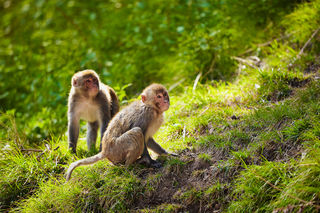Mind Reading
The Role of "Mindreading" Neurons
Neuroscientists discover brain cells that simulate another's mental process.
Posted April 11, 2019

We learn from watching others. Sometimes the lessons are crucial, such as when a baby learns from its mother which food is safe to eat and which is not. Sometimes the lessons are less critical but still useful. If you see someone order the same meal repeatedly at a restaurant, you have a good shot at predicting what he will ask for the next time. That knowledge might also inform your own choice of what to eat—the burgers must be good here, you think. Such observational or social learning requires a sophisticated cognitive process that has long been thought to include some simulation of other people’s mental processes.
Neuroscientists at the University of Cambridge have discovered a specialized set of neurons in the amygdala of monkeys that underpin part of this social aspect of decision-making. These “mindreading” or “simulation” neurons appear to reconstruct the mental process of a social partner based on prior observational learning. Their discovery may help scientists further understand the critical social skill of theory of mind. It could also provide insight into what goes wrong for people with autism and other disorders who have difficulty with social interactions.
“Our data suggest there could be two separate decision systems in the primate amygdala, one decision system for computing your own decisions and then a separate system for computing decisions of social partners,” says Cambridge neuroscientist Fabian Grabenhorst, who led the research.
The amygdala is a part of the brain that is associated with emotion. “The textbook function of the amygdala has been fear conditioning, learning about stimuli that are threats, and also recognizing emotion in other people,” Grabenhorst says. But in 2012, he and his colleagues reported the discovery of a set of “decision neurons” in the amygdala that were involved in reward-based decision-making. “When you make a decision between different options, you first assign a subjective value to the different options and then you make your choice,” Grabenhorst says. “This is precisely what decision neurons do. They first evaluate different options and then they signal the choice.”
Since the scientists knew the amygdala was involved in social behavior, they wanted to see if they could link decision-making to social observation. That led to the experiment in their new paper, which was published in Cell today and involves rhesus macaques, whose brains are homologous to humans and whose social behavior is also very similar in many regards to ours.
In the experiment, two monkeys sat opposite each other with a horizontal touchscreen between them. Pictures of colorful, abstract items appeared on the screen and each picture was associated with a specific probability of getting a juice reward. (Monkeys love juice.) Each monkey was presented with his own set of pictures and the animals took turns choosing between them. “The monkeys had to learn by trial and error which picture would give them more reward over time,” Grabenhorst says. “They could observe each other, and they could observe each other’s choices and learn from each other’s choices.”
Throughout the experiment, the scientists used a microelectrode to record the electrical activity of individual neurons in the amygdala of one of the monkeys. That meant that half the time the recorded monkey was choosing and half the time he was watching what his partner did. “The monkeys would learn the values of their own pictures from [their] own experiences. [Then] they learn the values of the pictures of the partner from observation. And then we switch the pictures between the monkeys,” Grabenhorst says. The switch was crucial. “That was the test to see whether one monkey had learned the value of the pictures from observing the partner make choices between these pictures.”
The researchers found that the decision neurons they had discovered did indeed assign a value to objects through observation, and not just a monkey’s own experience. But they also discovered that a separate set of neurons was doing something else—they "took these values learned from observation as inputs to a decision process,” Grabenhorst says. They eventually dubbed this second set of brain cells simulation neurons. “It’s as if these neurons play out a fictive decision computation to predict what the partner is going to do.”
They found that simulation neurons fired more strongly when the partner monkey was going to make a specific choice and fired less strongly when the partner monkey was going to make a different choice. “These are not clairvoyant neurons, but one monkey can predict the behavior of another monkey because he has observed that monkey and that monkey’s choices in the past,” Grabenhorst says.
Once they realized there were two different sets of neurons at work, Grabenhorst and his colleagues developed a sophisticated mathematical model to show how these neurons might work together. That model led them to the theory that there are two different decision-making systems in the brain, in other words, separate neurons processing our own and others’ decisions.
“We think this could be a basic building block for something more complex, like theory of mind in humans,” Grabenhorst says. Theory of mind, the ability to take someone else’s perspective, often proves difficult for people with a range of neurological and psychological disorders. The new findings could someday help clinicians and researchers better understand what is happening in the brain in those cases.
Copyright: Lydia Denworth, 2019




